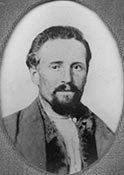William & Charlotte Baker Longstroth ~ Index

Charlotte Baker Longstroth, daughter of Simon Baker and Charlotte Leavitt, was born 5 April 1849 in Great Salt Lake City, Utah. As a young girl she helped her mother prepare wool, spin the yarn and dye it and then weave it into cloth. In June 1865, she went to Mendon, Cache County, with her brothers, Jarvis, Benjamin, Samuel, and Wiear. The journey took four days. They took with them horses, cows, pigs, sheep, and provisions to last from June to November. She made her home the first few months with her brother Albert M. and aunt Maria. Aunt Maria taught her much about cooking, sewing, and keeping house.
On 27 January 1868, Charlotte married William Longstroth in Mendon, Utah. Bishop Andrew Shumway performed the marriage. Later they were married in the Endowment House in Salt Lake City, October 1st, 1869.

William Longstroth, son of Stephen and Ann Gill Longstroth, was born 6 June 1840 in Lancaster, Lancastershire, England, the youngest of thirteen children. In 1838 Orson Hyde and Willard Richards, Mormon missionaries to the British Isles, had converted the Longstroth family. They embarked on a boat leaving Liverpool 5 February 1842 to go to Zion. William, who loved animals all his life, brought his beloved cat with him on this long and perilous journey.
The boat bringing the family to the United States docked at New Orleans. After landing, the family booked passage up the Mississippi River to St Louis, where they resided for a period of two years before moving to Nauvoo. The family crossed the plains with Apostle Willard Richards and company, arriving 19 October 1848. The Longstroth home in Salt Lake City was on Richards Street, where the Deseret News building now stands. Here on this same street they had their private cemetery.
As a young man, William was trained to be a harness maker. As Governor Dodson’s hostler he was very competent. He was a private in Captain Lot Smith’s company of Utah Cavalry Volunteers, being enrolled 13 April 1862 and discharged 16 August 1862. This was called The Snake River Expedition. Sixty men had the task of regaining three hundred horses and mules stolen by Indians.
Horses were William Longstroth’s greatest hobby. Everyone spoke of the fine horses he drove. He brought the first thoroughbred horses to Cache Valley. He used to train them on the race track near Allen Willie’s. Although William was not a trained veterinary, he seemed to understand animals and what to do for them.
In the spring of 1911 William caught pneumonia and after a short illness died, 19 March 1911, at Mendon, Utah. His wife died 29 November 1935, also at Mendon. They had born to them twelve children, seven daughters and five sons. An interesting autobiography of Charlotte Baker Longstroth survives, as told to her daughter,
The following are extracts:
The Old Fort in Salt Lake City was built of adobes. The North Fort and the South Fort were built of Logs. I can remember when I, as a child, played by the old mud wall. This wall was built by the people paying every tenth day’s work, or a tithe of their time. It was four feet thick at the base and about two feet thick at the top, twelve feet high and about five miles long. This wall commenced at the Hot Springs north of the city, went Southeast along the mountain and across to where the Capitol building now stands, and down City Creek Canyon.
Every fifty feet or so there was a pillar of mud built behind the wall for support, with peep holes made in three directions. When we used to herd the cattle around here we had great times pulling each other through these peep holes and running along the top of the wall.
I was sixteen years old when our family moved to Mendon. I helped Aunt Maria Baker cook for the boys. She was Albert’s first wife. Maria never had any children. My half brothers were willing to help my mother raise her family, she had been such a good mother to all of them. The property was divided among the children, mother having two families to care for. They accumulated a large herd of cattle and sheep and hogs. The boys drove the animals up to Cache Valley while I drove the team, without a spring seat or a cover over my head.
Notes…
The exploits of The Snake River Expedition are listed in the lower Andrew Bigler section. Also some of the noted events that occurred during their Civil War Service under Captain Lot Smith.